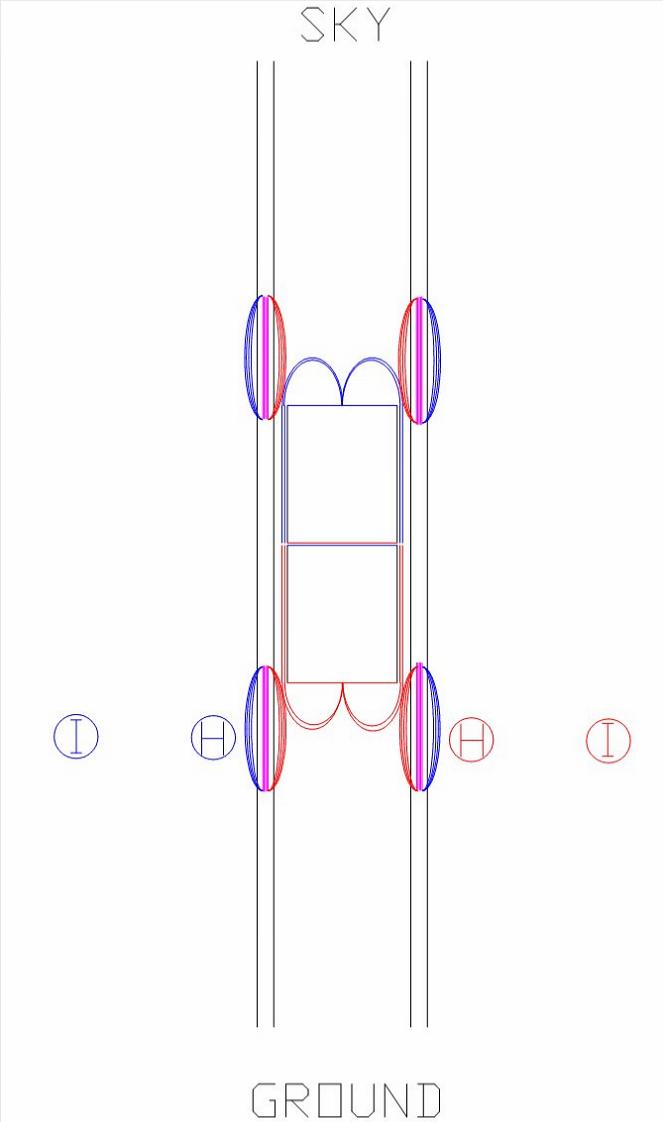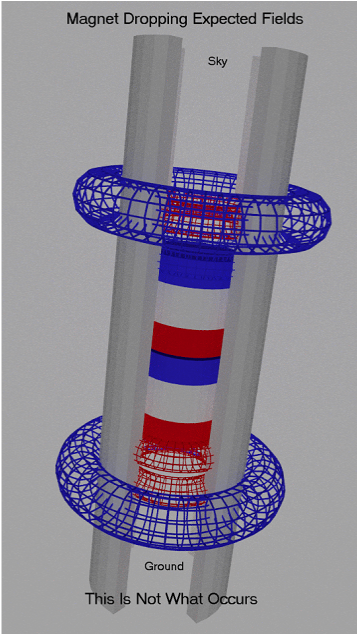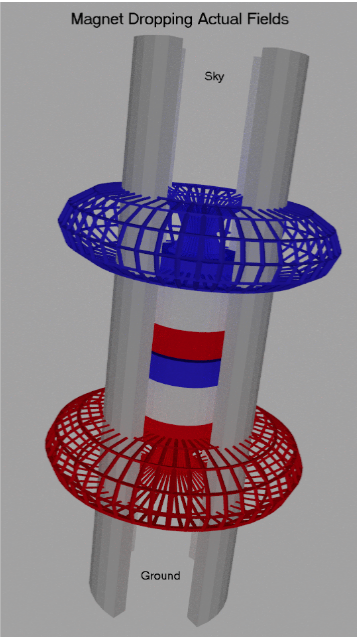
Electrodynamic Suspension And Braking
Dropping A Magnet Down A Non Magnetic Tube
I believe that this is the same type of phenomenon as moving a magnet over a horizontal conductor. Below is how the magnetic fields should appear. I have tested this setup with Hall Effect sensors. There are 2 magnets held together magnetically. They are each 28mm long x 19mm diameter (1 1/8" x 3/4") so 56mm x 19mm (2 1/4" x 3/4") of N35 rare earth magnets. The tube is aluminum 26mm ID x 3mm wall thickness x 1m length. The magnet takes 5 seconds to fall through.
I believe that this is the same type of phenomenon as moving a magnet over a horizontal conductor. Below is how the magnetic fields should appear. I have tested this setup with Hall Effect sensors. There are 2 magnets held together magnetically. They are each 28mm long x 19mm diameter (1 1/8" x 3/4") so 56mm x 19mm (2 1/4" x 3/4") of N35 rare earth magnets. The tube is aluminum 26mm ID x 3mm wall thickness x 1m length. The magnet takes 5 seconds to fall through.

As we can see, the magnet is dropping north pole (red) at the lower end. Eddy currents form in the tube, and create a north pole inside the tube at the lower end to oppose the action of the falling magnet. This must then create a south pole outside the tube at the lower end to complete the moving mirror image magnet. At the upper end of the permanent magnet, the south pole is also dropping, but to oppose the movement the eddy currents formed here must create a north pole in the tube wall and interior, to pull the magnet upwards. So outside the tube at the upper end, a south pole must be formed. The 2 "H" represent Hall Effect sensors for each polarity, and these are fully immersed in the magnetic fields. The "I" represent indicator lights. From the drawing, and commonly accepted theory, when the magnet is dropped, only the south pole indicator will illuminate. It should blink twice.
But this is not what happens.
But this is not what happens.

As the magnet falls, a mirror image field created by eddy currents, forms below the lower magnet, and into the tube wall. This field is the same polarity as the magnet and therefore opposes the fall. At the upper end of the magnet, a field opposing the fall is also formed. This field must be of opposite polarity to the upper magnet pole, as it needs to pull back on the magnet to oppose the fall.
As can be seen in Fig1, a field is shown outside the tube. Just as a magnet must have 2 poles, so also must a mirror image magnet have 2 poles. The eddy currents, while not shown here, would be in the tube wall. directly between the blue and red fields. This seems logical, as a long ring magnet mirror image is formed, with the NP on the ID, and a SP on the OD. This looks good, but does not occur.
Tests I have performed to determine the location and polarity of the fields generated by the falling magnet do not conform to this arrangement. The tests utilize Hall Effect sensors, 1 for North Pole and 1 for South Pole mounted about 10mm from the outer tube wall, with LED lights for visual confirmation. The actual fields are the real magnet's fields, and can be seen below.
Fig 1

I am using 1 metre of 26mm ID alum tube with 3mm wall thickness. The magnet is 2 x 19mm diameter x 28mm long, neo N35 rare earth type. The magnet pair takes 5 seconds to drop through the tube. This is quite slow enough to observe the light sequence. It is about 25 times slower than dropping through the air. The fall appears to be non accelerative.
Fig 3 is the actual field arrangement when the magnet is dropped, when it is lowered slowly, when it is raised slowly or held stationary.
There is no change in the sequence of LED illumination, nor apparent strength of the fields.
When the magnet is lowered slowly, or when it is raised slowly
the drag is quite evident.
Eddy currents and their mirror image fields are easy to theorize, but difficult to find.
The slowing of the magnet is not proof of eddy currents and mirror image magnetic fields in non magnetic conductors.
Fig 3 is the actual field arrangement when the magnet is dropped, when it is lowered slowly, when it is raised slowly or held stationary.
There is no change in the sequence of LED illumination, nor apparent strength of the fields.
When the magnet is lowered slowly, or when it is raised slowly
the drag is quite evident.
Eddy currents and their mirror image fields are easy to theorize, but difficult to find.
The slowing of the magnet is not proof of eddy currents and mirror image magnetic fields in non magnetic conductors.
Fig 3
The drawings above show 2 magnets. This makes a very powerful single magnet. The central part effectively has no field. The diagrams show a cutaway tube for clarity, but tests performed used a complete tube.
Hall Effect sensors have no effect on the magnetic field which is being sensed.
Dropping a magnet through a non magnetic conductor appears to be a form of Electrodynamic Braking. As the fall is non accelerative, it could also be suggested that it is anti gravitational.
Dropping a spinning magnet down the tube, or dropping a magnet down a spinning tube may be interesting. I suspect the magnet would fall even slower.
Dropping a magnet through a non magnetic conductor appears to be a form of Electrodynamic Braking. As the fall is non accelerative, it could also be suggested that it is anti gravitational.
Dropping a spinning magnet down the tube, or dropping a magnet down a spinning tube may be interesting. I suspect the magnet would fall even slower.

